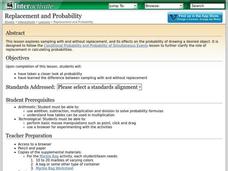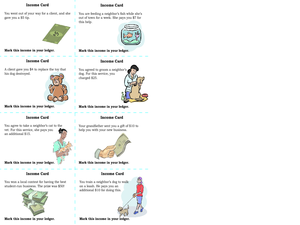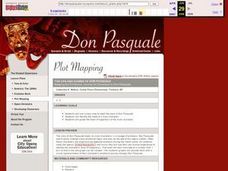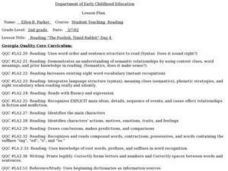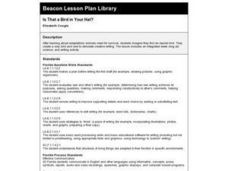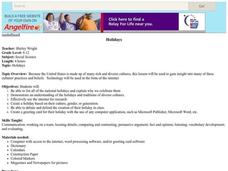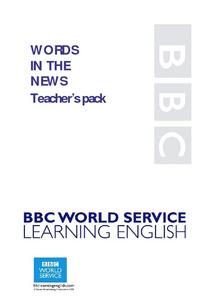Curated OER
Greek Prefixes In Science
Seventh graders look into their science textbooks to find words that utilize the Greek prefixes, "anti," "epi," "endo," and "micro." Student pairs complete a worksheet embedded in the plan where they list as many of these words as they can.
Curated OER
Talking About Your Name in Math Terms
Add imagination and creativity to your math lesson. Young mathematicians investigate ways to express their names in mathematical terms. For instance, they can count the number of letters, analyze the geometric shapes of the letters, or...
Curated OER
Number Base Clocks
Students investigate place value in base ten. In this number sense lesson plan, students participate in an online lesson plan at www.shodor.org/interactivate/activities/NumberBaseClocks and demonstrate how to convert numbers from base...
Curated OER
Pythagorean Theorem
In this measurement lesson, learners examine the Pythagorean Theorem, perimeter, and areas of right triangles. They record their measurements and research their findings on a grid.
Shodor Education Foundation
Surface Area of Rectangular Prism
With this interactive lesson, learners compute the surface area of rectangular prisms. They visit an online investigation applet and record data on the provided handout. Pair this lesson with the volume lesson by the same publisher as an...
Curated OER
Comparison of Juan Bautista de Anza and George Washington
Fifth graders discover that Anza and Washington lived at the same time but on opposite sides of the American Continent. They identify differences and similarities in their lives. They present the data in an illustrated time line
Curated OER
Interactivate - Lines, Rays, Line Segments, and Planes
Learners explore lines, rays, line segments, and planes. In this math lesson, students discuss the math concepts and direct their instructor in graphing functions. Learners collaborate in graphing additional functions.
Shodor Education Foundation
Replacement and Probability
Middle and high schoolers explore the concept of probability. In this probability lesson, learners conduct an experiment with a bag of marbles. Pupils draw marbles from a bag and determine the probability of drawing a particular color...
Curated OER
Growing Poems
Young scholars write garden inspired poetry. In this poetry lesson plan, students go out into the garden and write poems about how they feel, what they see, and what is going on in the garden.
Curated OER
What Can You Do With Money?
Students watch a Biz Kidz video about money, learn what they can do with money, and fill out worksheets on what they learn. Students learn about spending, saving, donating, and investing.
Curated OER
Income and Expenses
Students discuss income and expenses. In this lesson on money, students define income and expenses, after whith they keep track of their income and expense transactions on a basic ledger.
Curated OER
The Ups and Downs of don Pasquale: Mapping the Emotional Journey of Characters in Don Pasquale
Students listen to and retell the story of Don Pasquale. They evaluate the emotions of the main characters. Students create a graph of the emotions of Don Pasquale.
Curated OER
Combining Syllables to Form 2- and 3-Syllable Words
Students practice combining consonant-vowel-consonant sounds to form words. They read closed and silent "e" syllables. Students construct two-syllable words. They arrange syllables to form three and four syllable words.
Curated OER
Literary Elements in Of Mice and Men
Ninth graders review an exercise, after reading most of the novel Of Mice and Men by John Steinbeck. They demonstrate a range of literary elements such as conflict, symbolism, setting, and foreshadowing. Students also are able to provide...
Curated OER
Bird Banners
Learners create banners for their classroom that contain the same information as field guides.
Curated OER
Language Arts: Plotting Stories
Second graders read the story, "The Foolish, Timid Rabbit," as part of a unit on appearances. After reading with partners, they write their own stories that include elements about some forms of matter from their science studies. Students...
Curated OER
Is That a Bird in Your Hat?
Second graders imagine they find an injured bird. They create a clay bird and nest to stimulate creative writing. The lesson includes an integrated week-long art, science, and writing activity.
Curated OER
Introduction to "The Secret School"
Fourth graders read The Secret School and define vocabulary in the text. In this Secret School lesson, 4th graders recognize difficult text and are able to comprehend its meaning and answer questions.
Curated OER
Holidays
Students make a list of all of the national holidays and explain why we celebrate them. They create a holiday based on their culture, gender, or generation and then debate and defend the creation of their holiday in class. They create...
Curated OER
Getting into Hot Water
Young scholars discuss the effect of global warming on bodies of water after reading "An Icy Riddle as Big as Greenland" from The New York Times. Students work in groups to research topics related to global warming and Greenland's...
Curated OER
Finding Our Bonds: King Day
Students explore the concept of philanthropy. In this service learning lesson, students experience literature and participate in a simulation that examines discrimination, prejudice, and stereotypes.
Curated OER
Words in the News Smoking Ban- 15 February 2006
Students complete vocabulary building exercises before reading an online article. They complete worksheets and an online quiz. They focus on relaltive clauses on the final worksheet. They write a letter about second hand smoke in a...
Curated OER
Nutrients
Fourth graders understand the important nutrients in food and the value of each. In this nutrients lesson, 4th graders complete a chart giving examples of foods that contain that nutrient and a definition of the nutrient. Students...
Curated OER
Laurence Yep's, Dragonwings
Students discuss vocabulary words and compare definitions. They read chapters 6-9 of the novel, Dragonwings, and discuss point of view, and complete a plot diagram. Then they review the four types of conflict and identify the conflicts...







